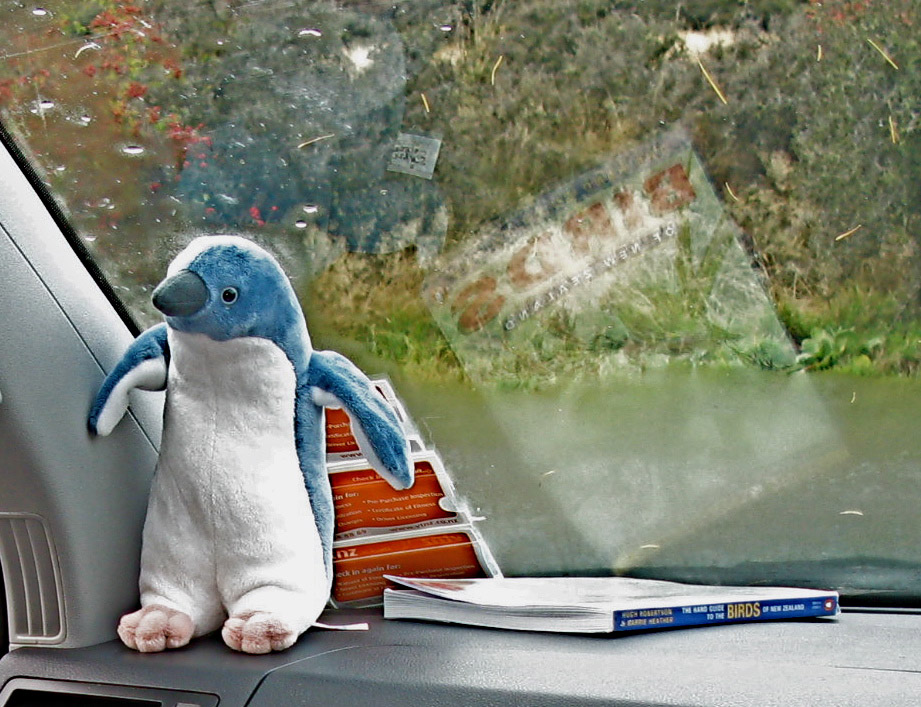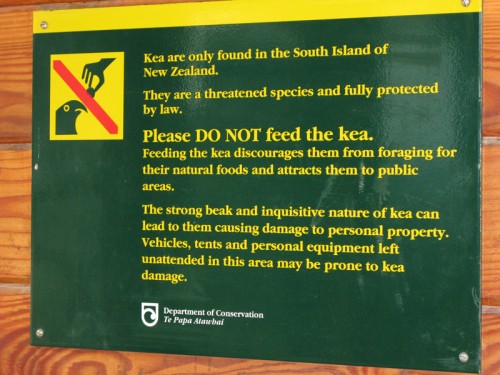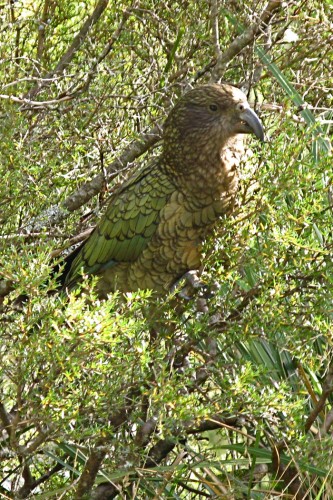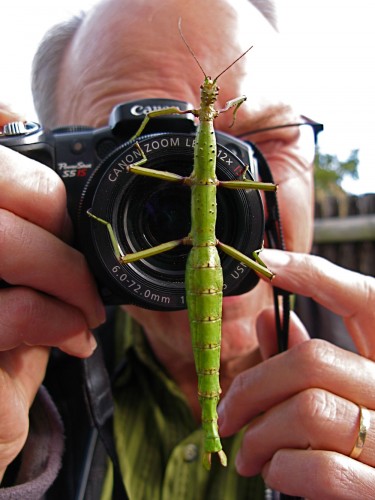Alpine Parrots…no, really, parrots at tree-line.
If you were a parrot, would you live in this chilly realm?
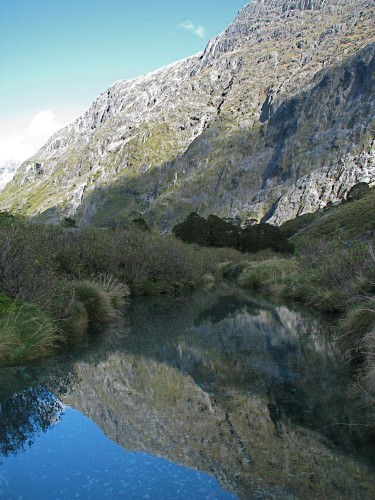 Yes, if you’re a Kea. A large, endemic NZ parrot, the bronze-green Kea (Nestor notabilis) spends most of its time in high alpine areas and steep rocky valleys of the mountains of New Zealand’s South Island.
Yes, if you’re a Kea. A large, endemic NZ parrot, the bronze-green Kea (Nestor notabilis) spends most of its time in high alpine areas and steep rocky valleys of the mountains of New Zealand’s South Island.
Kea can be easy to photograph because of some bad habits they’ve taken up, like hanging around places where people park cars in mountain turnouts, hiking huts, and ski areas. They are industrious, strong-beaked and curious, and will methodically shred back-pack, tent, or windshield wipers just because it’s entertaining. The Department of Conservation has had to put up signs about this mischievous beakhavior:
Their destructiveness has gotten them into a lot of trouble with people, and although things are slightly better now that they are fully protected, Keas have had a bounty on their heads most of the last century, as sheep killers.
(This is as controversial an issue in NZ as wolf-attacks on humans in the US: do they or don’t they? Apparently, video exists of Keas consuming flesh off the fatty area above the kidneys of living sheep…)
Though they spend a lot of time on the ground, Keas are strong flyers, and we were lucky enough to see a pair larking and calling loudly from over a high patch of beech forest in craggy, snow-dusted Fjordlands terrain. This is more satisfying than seeing them scouting for food from tourists at the entrance to the one-way Homer Tunnel where vehicles must wait for up to 15 minutes for a green light. But it’s easier to get photos of them there, and here’s one of a Kea doing a pretty good impression of a roadrunner.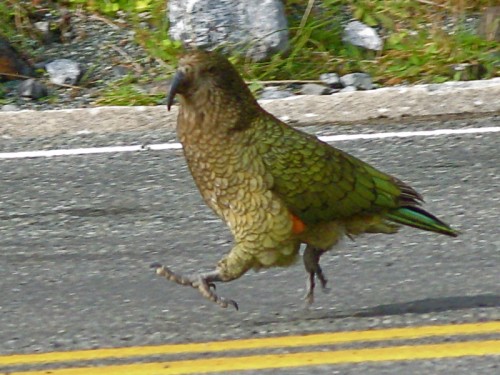
(Photos, Top: E. Shock; Kea and Kea running, A. Shock)
Serendipity: Fernbirds, penguins, and hogget in between
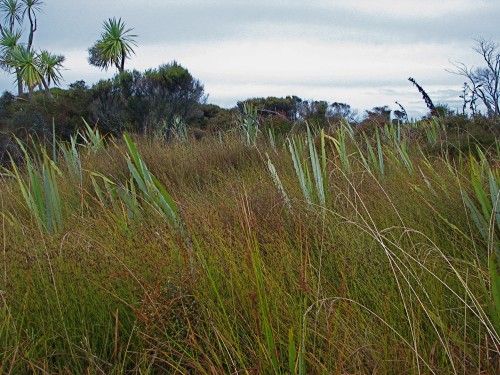 This day was full of serendipity: we happened upon the lady with fernbirds in her yard; we went to Curio Bay for fossils, but happened upon Yellow-eyed penguins; and in between? Hogget: it’s an age category of sheep meat between lamb and mutton, which we happened upon in the Invercargill Pack-n-Save butchery.
This day was full of serendipity: we happened upon the lady with fernbirds in her yard; we went to Curio Bay for fossils, but happened upon Yellow-eyed penguins; and in between? Hogget: it’s an age category of sheep meat between lamb and mutton, which we happened upon in the Invercargill Pack-n-Save butchery.
What a day!
 Here is the AA signpost to Bushy Point Fernbirds, where Jenny showed us half a dozen of the mousy, streaky, spiky-tailed birds in her Joint-rush refuge property within 1/2 an hour. No photos of birds — too dark still, and they Fernbirds is furtive — but above is a photo of their lovely habitat: rush, flax, cabbage trees and manuka, all very NZ.
Here is the AA signpost to Bushy Point Fernbirds, where Jenny showed us half a dozen of the mousy, streaky, spiky-tailed birds in her Joint-rush refuge property within 1/2 an hour. No photos of birds — too dark still, and they Fernbirds is furtive — but above is a photo of their lovely habitat: rush, flax, cabbage trees and manuka, all very NZ.
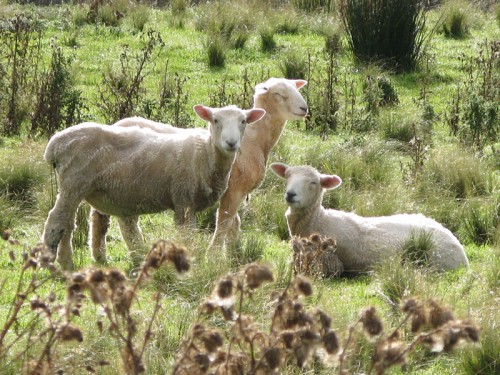 Mutton on the hoof or hoggett? I lean toward hogget, but only the butcher knows for sure. (“It’s the teenage sheep!” the girl explained in the grocery).
Mutton on the hoof or hoggett? I lean toward hogget, but only the butcher knows for sure. (“It’s the teenage sheep!” the girl explained in the grocery).
A freshly-moulted Yellow-eyed penguin just popped ashore for the night at Curio Bay. It’s standing on Jurassic fossils of a buried podocarp and tree fern forest, but is more interested in preening than geology: penguins may have even less of a concept of fossils than of trees.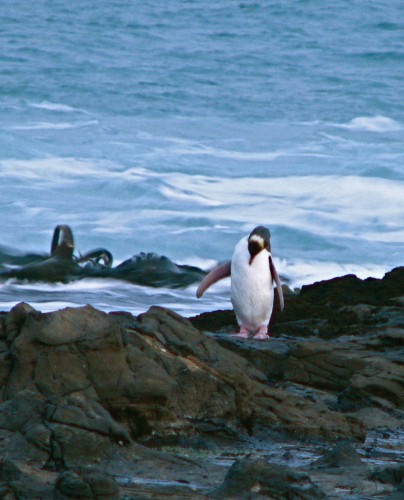
(Photos by A. and E. Shock; do click on each to enlarge, they’re so much better…)
When is a Wood Hen a Beach Bunny?
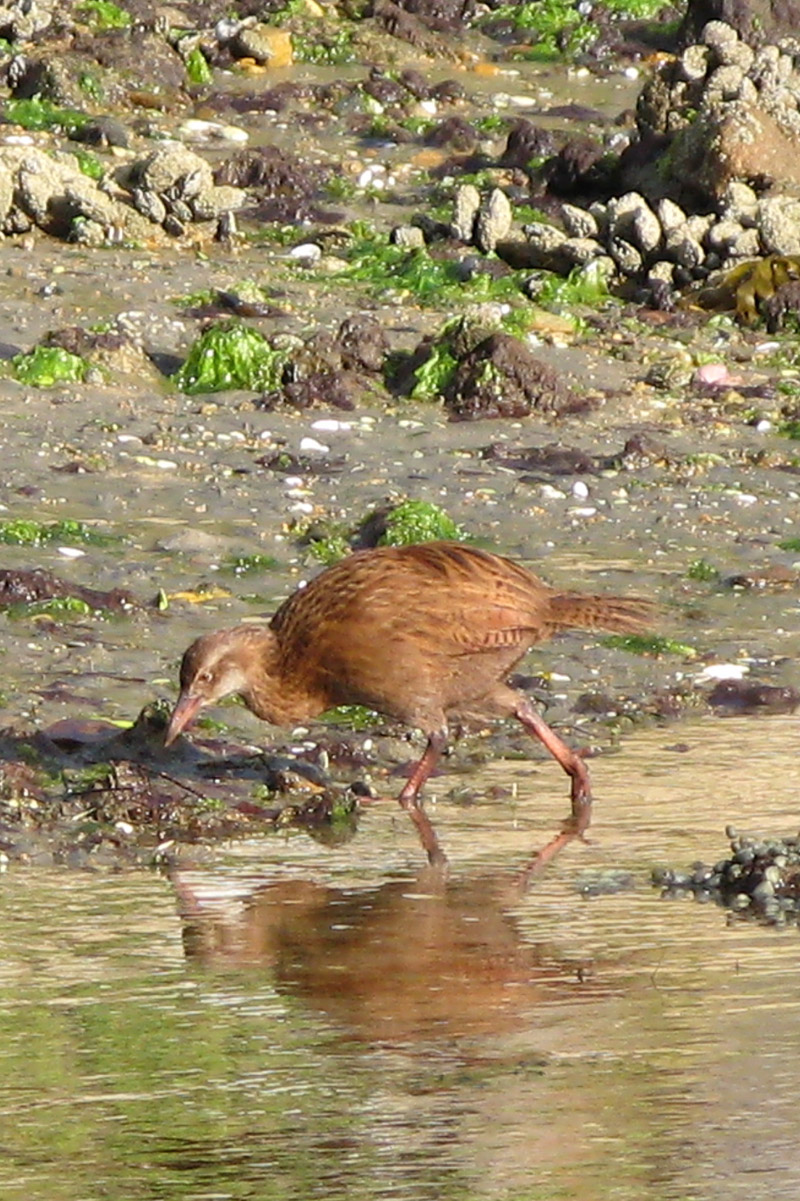 When it’s a Weka (pronounced “wehkkah”, Gallirallus australis), a biggish flightless endemic NZ rail.
When it’s a Weka (pronounced “wehkkah”, Gallirallus australis), a biggish flightless endemic NZ rail.
If you’ve ever tried to see a rail in the US, you know it can be an exercise in frustration, since our rails are furtive and well-camouflaged wetlands birds. Designed to slip secretly through reeds and sedges (as in “thin as a…”), they are far more often heard than seen.
Not so in Ulva Island NZ (a small refuge islet just offshore of Stewart Island), where the Weka is common, and emerges from the bush in broad daylight to forage the low tide line on the beaches of the Island, where it looks like a chestnut-colored chicken with a project. In this habitat, Weka function as diurnal Kiwi birds, because they occupy roughly the same niche as the Kiwi, who also leave the forest for the small-invertebrate-rich strands, except usually at night.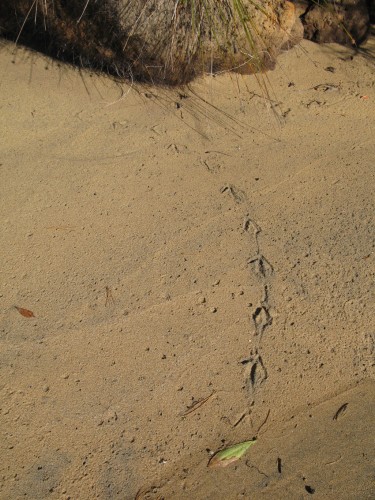
In fact, the indigenous name for the Stewart Island Brown Kiwi is Tokoeka, which according to some means “Weka with a Walkingstick” (the wooden kind, not the bug kind) in reference to the long bill of the otherwise similarly-shaped Kiwi bird. One beach we visited had four in the vicinity, but if you should by chance miss the Weka, look for the undulating lines of big-toed footprints leading out of the bush.
(Photos by A. Shock)
Walkingstick sequel: in case anyone was wondering…
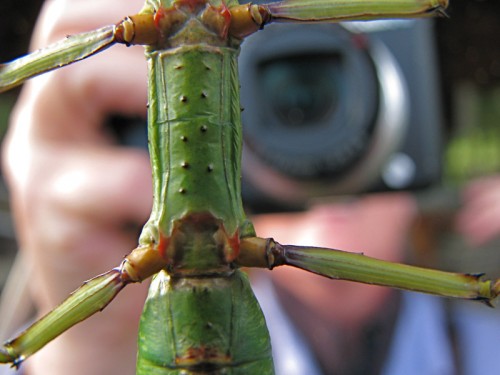 …how the photo E was taking turned out (from this post), here it is. Now you know what the ventral surface of a NZ walking stick looks like.
…how the photo E was taking turned out (from this post), here it is. Now you know what the ventral surface of a NZ walking stick looks like.
Piwakawaka and other obliging Non-Kiwi Kiwis
Proper Kiwi birds are nearly impossible to take photos of. Mainly because most kiwi birds are nocturnal and using flash is rude, but also because they’re hard to see in their environment, rummaging around in the deep ferny forest floor. And anyway they’re terribly difficult to find at all.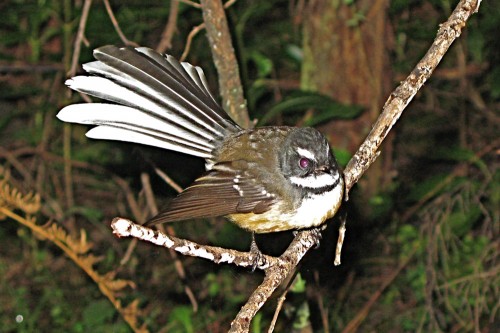
But there are other, non-Kiwi birds who are not so shy.
Piwakawaka is the exuberant Maori name for the Fantail (Rhipidura fuliginosa), a common native bird in New Zealand bush (areas forested with native trees and plants). This is one cheeky chicky: they’ll flit right up and swoop in to capture any bugs that may be hanging out around you as you hike, sometimes following for quite a distance down the trail, sometimes nearly — but not quite — landing on you.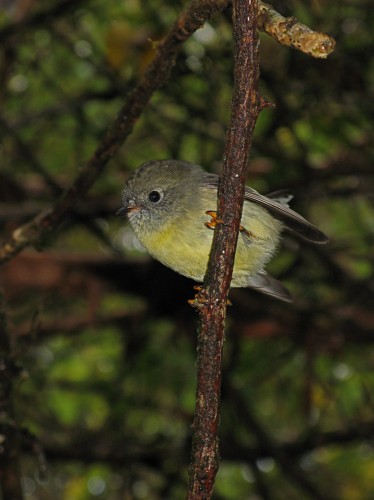
A couple of other birds do the same thing: the engaging Miromiro (Tomtit, Petroica macrocephala), the more reserved Toutouwai (New Zealand Robin, Petroica australis), so they are relatively easily photographed. (These last two birds, the NZ Robin and the Tomtit are endemic to NZ, occurring nowhere else, while the Fantail also lives in Australia).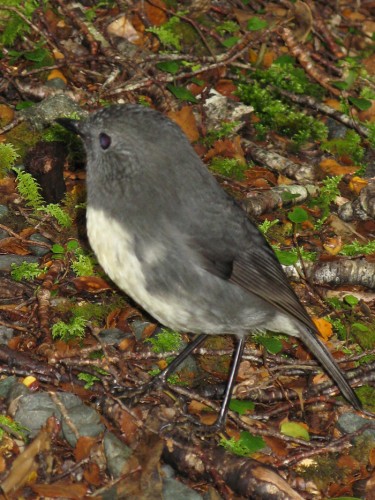
Top to bottom, here are photos of Piwakawaka (Fantail), an immature Miromiro (Tomtit), and Toutouwai (NZ Robin) (Photos by A. Shock).
Some swell cetaceans
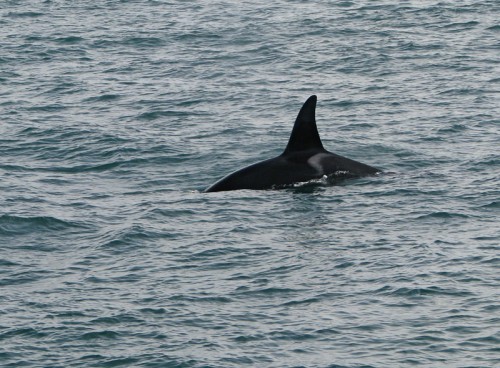 NZ has lots of coastline, and there are plenty of opportunities to get out onto the sea. During ferry trips, either getting to offshore islands or between big islands, or on small boats looking for sea birds, there’s almost always something to see — and not always birds.
NZ has lots of coastline, and there are plenty of opportunities to get out onto the sea. During ferry trips, either getting to offshore islands or between big islands, or on small boats looking for sea birds, there’s almost always something to see — and not always birds.
Returning to the mainland from Tiri Tiri Matangi, the ferry captain spied a pod of orca feeding on sting rays in the relatively shallow water of the Hauraki Gulf — here’s the dorsal fin of a male.
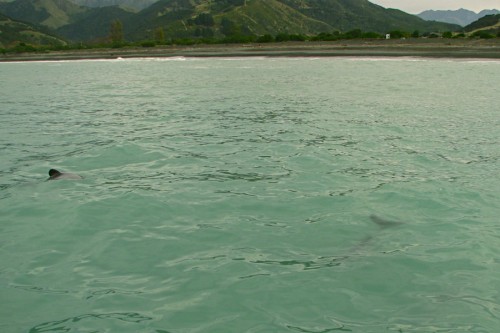 On a pelagic trip off Kaikoura, eastern South Island, we came across a small group of endangered Hector’s dolphins — quite tiny dolphins with distinctive paddle-shaped dorsal fins. There are actually two dolphins in this photo. They’re a bit difficult to see, but there’s a dorsal fin visible on the left edge of the picture, and near the bottom right, (especially if you enlarge by clicking) you can see the shadow of a little dolphin just under the surface. These guys were a bit shy, and didn’t sport around the boat.
On a pelagic trip off Kaikoura, eastern South Island, we came across a small group of endangered Hector’s dolphins — quite tiny dolphins with distinctive paddle-shaped dorsal fins. There are actually two dolphins in this photo. They’re a bit difficult to see, but there’s a dorsal fin visible on the left edge of the picture, and near the bottom right, (especially if you enlarge by clicking) you can see the shadow of a little dolphin just under the surface. These guys were a bit shy, and didn’t sport around the boat.
(Photos E Shock)
Large, colorful, flightless, and clueless…
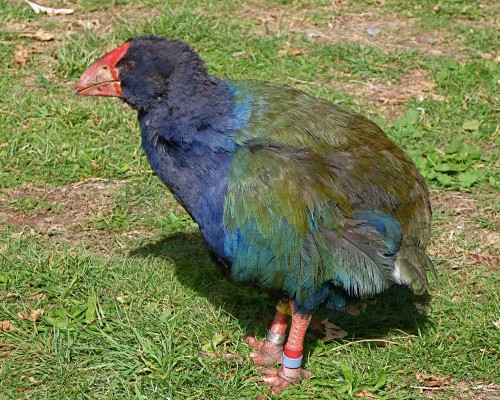 …that’s the Takahe, a mountain-dwelling, tussock-eating, big-beaked member of the gallinule family (related to coots). The bird was believed by ornithologists to be extinct, until G.B. Orbell “rediscovered” a population in the remote Murchison mountains of Fjordland New Zealand in 1948. Since then heroic efforts have been made to secure its survival as a species, which are so far uncertainly successful (in 2004, there were fewer than 200 birds in the wild, and less than 50 in captivity).
…that’s the Takahe, a mountain-dwelling, tussock-eating, big-beaked member of the gallinule family (related to coots). The bird was believed by ornithologists to be extinct, until G.B. Orbell “rediscovered” a population in the remote Murchison mountains of Fjordland New Zealand in 1948. Since then heroic efforts have been made to secure its survival as a species, which are so far uncertainly successful (in 2004, there were fewer than 200 birds in the wild, and less than 50 in captivity).
Above is a free-living wild Takahe, photographed on Tiri Tiri Matangi sanctuary in the North Island of New Zealand — I’m uncertain that it appears to appreciate all the effort taken on its behalf.
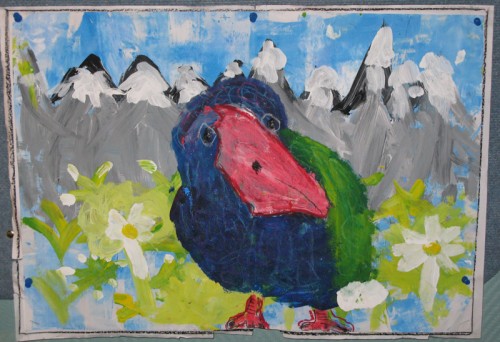 Then take a look at the most excellent kid’s painting tacked to a wall (no name supplied) at the Fjordlands National Park Visitors Center in Te Anau. Isn’t it perfect?
Then take a look at the most excellent kid’s painting tacked to a wall (no name supplied) at the Fjordlands National Park Visitors Center in Te Anau. Isn’t it perfect?
(Photos A. Shock)

